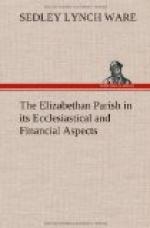Church-ales were usually held at or near Whitsuntide, hence they were also called Whitsun-ales or May-ales in the accounts. If the occasion were an extraordinary one, and it was sought to realize a large sum, notices were sent to the surrounding parishes, say to ten, fifteen, or more, to be read aloud from the pulpits of their respective churches after service, which notices contained invitations to any and all to come and spend their money in feasting and drinking for the benefit of the parish giving the ale. As the day approached for the opening of the ale, which, if it were a great one, would be kept for four or five days or more, all was bustle in the parish to prepare for a feasting which often assumed truly Gargantuan proportions. Cuckoo kings and princes were chosen, or lords and ladies of the games; ale-drawers were appointed. For the brewing of the ale the wardens bought many quarters of malt out of the church stock, but much, too, was donated by the parishioners for the occasion. Breasts of veal, quarters of fat lambs, fowls, eggs, butter, cheese, as well as fruit and spices, were also purchased. Minstrels, drum players and morris-dancers were engaged or volunteered their services. In the church-house, or church tavern, a general-utility building found in many parishes, the great brewing crocks were furbished, and the roasting spits cleaned. Church trenchers and platters, pewter or earthen cups and mugs were brought out for use; but it was the exception that a parish owned a stock of these sufficient for a great ale. Many vessels were borrowed or hired from the neighbors or from the wardens of near-by parishes, for, as will presently be seen, provident churchwardens derived some income from the hiring of the parish pewter as well as money from the loan of parish costumes and stage properties. When the opening day arrived people streamed in from far and wide. If any important personage or delegation from another village were expected, the parish went forth in a body with bag-pipes




